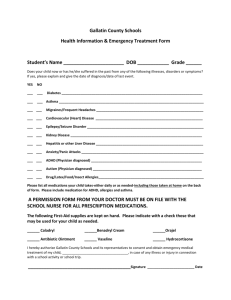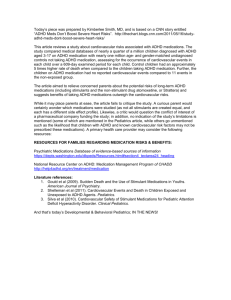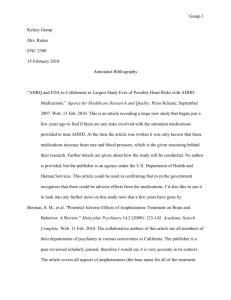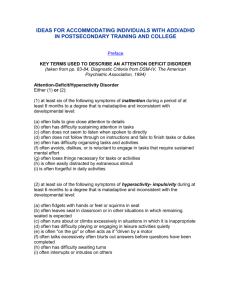Stimulant Medications and ADHD – Fact Sheet
advertisement
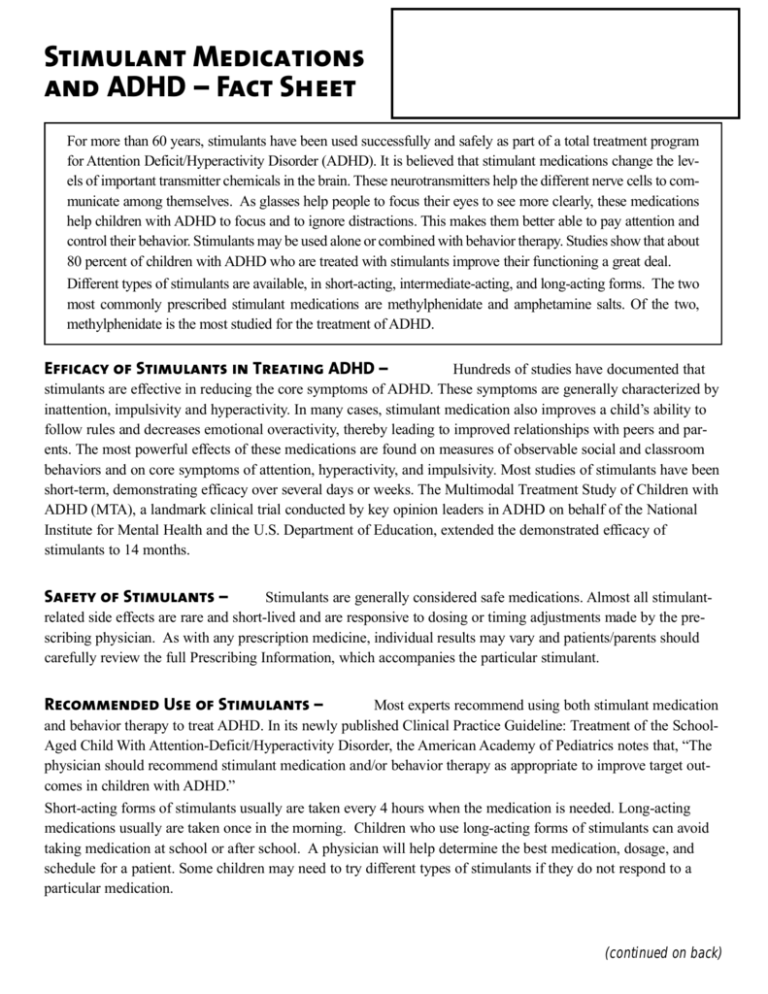
Stimulant Medications and ADHD – Fact Sheet For more than 60 years, stimulants have been used successfully and safely as part of a total treatment program for Attention Deficit/Hyperactivity Disorder (ADHD). It is believed that stimulant medications change the levels of important transmitter chemicals in the brain. These neurotransmitters help the different nerve cells to communicate among themselves. As glasses help people to focus their eyes to see more clearly, these medications help children with ADHD to focus and to ignore distractions. This makes them better able to pay attention and control their behavior. Stimulants may be used alone or combined with behavior therapy. Studies show that about 80 percent of children with ADHD who are treated with stimulants improve their functioning a great deal. Different types of stimulants are available, in short-acting, intermediate-acting, and long-acting forms. The two most commonly prescribed stimulant medications are methylphenidate and amphetamine salts. Of the two, methylphenidate is the most studied for the treatment of ADHD. Efficacy of Stimulants in Treating ADHD – Hundreds of studies have documented that stimulants are effective in reducing the core symptoms of ADHD. These symptoms are generally characterized by inattention, impulsivity and hyperactivity. In many cases, stimulant medication also improves a child’s ability to follow rules and decreases emotional overactivity, thereby leading to improved relationships with peers and parents. The most powerful effects of these medications are found on measures of observable social and classroom behaviors and on core symptoms of attention, hyperactivity, and impulsivity. Most studies of stimulants have been short-term, demonstrating efficacy over several days or weeks. The Multimodal Treatment Study of Children with ADHD (MTA), a landmark clinical trial conducted by key opinion leaders in ADHD on behalf of the National Institute for Mental Health and the U.S. Department of Education, extended the demonstrated efficacy of stimulants to 14 months. Safety of Stimulants – Stimulants are generally considered safe medications. Almost all stimulantrelated side effects are rare and short-lived and are responsive to dosing or timing adjustments made by the prescribing physician. As with any prescription medicine, individual results may vary and patients/parents should carefully review the full Prescribing Information, which accompanies the particular stimulant. Recommended Use of Stimulants – Most experts recommend using both stimulant medication and behavior therapy to treat ADHD. In its newly published Clinical Practice Guideline: Treatment of the SchoolAged Child With Attention-Deficit/Hyperactivity Disorder, the American Academy of Pediatrics notes that, “The physician should recommend stimulant medication and/or behavior therapy as appropriate to improve target outcomes in children with ADHD.” Short-acting forms of stimulants usually are taken every 4 hours when the medication is needed. Long-acting medications usually are taken once in the morning. Children who use long-acting forms of stimulants can avoid taking medication at school or after school. A physician will help determine the best medication, dosage, and schedule for a patient. Some children may need to try different types of stimulants if they do not respond to a particular medication. (continued on back) Potential for Abuse – Stimulants are classified as Schedule II drugs by the U.S. Drug Enforcement Administration. There are some news media and anecdotal reports of abuse of this class of medication. However, these incidents are not widespread. In its “Practice Parameter for the Use of Stimulant Medications in the Treatment of Children,Adolescents, and Adults,” the American Academy of Child and Adolescent Psychiatry notes: “Analyses of annual school surveys of drug use and the Drug Abuse Warning Network data on emergency room visits, however, have not suggested increased abuse or diversion of methylphenidate.” The US General Accounting Office recently evaluated the issue of diversion and abuse of attention disorder drugs and concluded the following: “We do not believe that the diversion or abuse of attention disorder medications is a major problem at middle or high schools. Based on our findings, few middle or high school principles are aware of ADHD medication diversion or abuse, and most do not believe this is a major problem. Furthermore, states and localities appear to be cognizant of the potential for problems and many have established policies and procedures to minimize risks.” Additionally, in a review of published literature surrounding the use of medications in the treatment of ADHD from children through adulthood, researchers noted: “Despite the concern that ADHD may increase the risk of abuse in adolescents and young adults (or their associates), there are no scientific data confirming the abuse of prescribed stimulants by ADHD children who are receiving appropriate diagnosis and careful follow-up.” Different stimulant medications may have different abuse potentials. Careful selection of a stimulant therapy, together with close monitoring, can ensure both treatment compliance and minimization of abuse potential. If a child is on medication, it is always best to supervise the use of the medication closely. References: American Academy of Pediatrics, Committee on Quality Impr ovement and Subcommittee on Attention-Deficit/Hyperactivity Disorder. Clinical Practice Guideline: Diagnosis and evaluation of the child with attention-deficit/hyperactivity disorder. Pediatrics 2000;105:1158-1170. American Academy of Pediatrics, Committee on Quality Improvement and Subcommittee on Attention-Deficit/Hyperactivity Disorder. Clinical Practice Guideline: Treatment of the school-a ged child with attention-deficit/hyperactivity disorder. Pediatrics 2001;108:1033-1044. The MTA Cooperative Group. A 14-month randomized clinical trial of treatment strategies for attention-deficit/hyperactivity disorder. Arch Gen Psychiatry 1999;56:1073-1086. Spencer T, Biederman J, Wilens T, Harding M, O'Donnell D, Griffin S. Pharmacotherapy of attention-deficit hyperactivity disorder across the life cycle. J Am Acad Child Adolesc Psychiatry 1996;35(4):409-432. U.S. General Accounting Office. Attention Disorder Drugs: Few Incidents of Diversion or Abuse Identified by Schools; Report to Congressional Requestors, September 2001. Biederman, J, Wilens T, Mick, E, Spencer, T, Faraone, S. Pharmacotherapy of Attention-deficit/Hyperactivity Disorder Reduces Risk for Substance Use Disorder. Pediatrics 1999;104(2):e20. American Academy of Child and Adolescent Psychiatry. Practice Parameter for the use of Stimulant Medications in the Treatment of Children,Adolescents, and Adults. J Am Acad Child Adolesc Psychiatry 2002;41(2 Supplement):26S-49S. THE AMERICAN ACADEMY OF FAMILY PHYSICIANS FOUNDATION HAS FAVORABLY REVIEWED THIS MATERIAL THROUGH 2005. FAVORABLE REVIEW MEANS THAT MEDICAL INFORMATION IS ACCURATE, BUT DOES NOT IMPLY ENDORSEMENT OF ANY CONCLUSIONS PRESENTED. © 2002 McNeil Consumer & Specialty Pharmaceuticals 0204011PR

